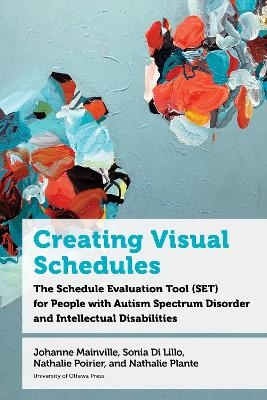
Creating Visual Schedules
University of Ottawa Press (Verlag)
978-0-7766-3972-7 (ISBN)
The SET is a time structure assessment tool that measures the pictorial schedule needed by individuals with Autism Spectrum Disorder (ASD) or Intellectual Disabilities (ID). These individuals typically have deficits in executive function and memory, and therefore have difficulty orienting themselves in time.
The goal of the SET is to help caregivers and professionals working with these individuals to determine the type of schedule best suited to their needs and abilities and to implement it in their living environment, thereby promoting their autonomy and, consequently, their quality of life.
The SET includes materials, protocols and a manual that allow practitioners and professionals to assess the schedule of children, adolescents and adults in various settings such as educational daycare, school, internship or employment and residential settings.
The SET is divided into four distinct parts. The first part involves the manipulation of objects, photographs, pictograms and words in a formal assessment context. The second and third parts take place directly in the setting where the schedule is to be implemented. The fourth part is administered in the form of an interview with the person who knows the person best in the context where the schedule will be introduced.
Available formats: hardcover, trade paperback, accessible PDF, and accessible ePub
Nathalie Poirier (Author) Dr. Nathalie Poirier is a psychologist, neuropsychologist, full professor and researcher in the Department of Psychology at the University of Québec at Montréal where she directs the Research Laboratory on the Families of Children with Autism Spectrum Disorders. Her research projects focus on the quality of life of parents of children with ASD. She is the co-author of several books on autism and received the OSER INNOVER award for the OUEST tool. Johanne Mainville (Author) Johanne Mainville, M.Ps., is a clinical psychologist in private practice, where she works with individuals with autism spectrum disorders and their families, and a consultant for the Service Québécois d'Expertise en Troubles Graves du Comportement (SQETGC). Nathalie Plante (Author) Nathalie Plante works as a regional support officer for students with ASD for the French school boards in the Montreal area. She supports the development of projects that contribute to the academic success of students with ASD. She is also a certified TEACCH® consultant from the University of North Carolina and is very involved in the deployment of this approach in Quebec. Sonia Di Lillo (Author) Sonia Di Lillo B.Sc. has worked for approximately 20 years as a clinical activities specialist in the health and social services network. Her expertise is the support of teams working with people with severe behavioral disorders (SBD). She now devotes herself entirely to teaching and supervision in the Special Education Techniques Department of the Cégep du Vieux-Montréal.
List of Figures - xi
List of Excerpts - xiii
Description of Supplementary Material - xv
Foreword - xvii
Acknowledgements - xix
Presentation - A1
The Importance of a Schedule - A2
The SET’s Main Objectives - A3
Target Population - A3
Examiner Training - A3
Evaluating Schedule Characteristics
Introduction - A7
The Eight Schedule Characteristics Evaluated Using the SET - A7
Schedule Evaluation Sequence - A8
Required Material - A8
Overview of the Schedule Evaluation Protocol - A9
Symbol Meaning - A10
Information on the Visual Supports Used During the Evaluation - A10
Part 1 - A13
Goal - A13
Duration - A13
Administration - A13
Sequence - A14
1. Prepare the Material for Evaluating Part 1 - A14
2. Identify Where to Start the Evaluation - A15
3. Use the Stop Standards to Identify Which Section or Subsection to Evaluate Next - A15
4. Demonstrations, Evaluation, and Scoring - A16
4.1. Detailed Procedure for 1A Subsections - A21
4.2. Detailed Procedure for 1B Subsections - A23
4.3. Detailed Procedure for 1C Subsections - A29
5. Scoring Part 1 in the Schedule Evaluation Protocol - A36
Part 2 - A45
Goal - A45
Duration - A45
Administration - A45
Sequence - A46
1. Fill in the Required Information in the Schedule Evaluation Protocol - A46
2. Choose the Visual Support Category to Evaluate - A47
3. Determine Where the Matching Boxes Will Be Installed - A47
4. Prepare the Material for Part 2 - A50
5. Prepare the Material for the Visual Support Form to Evaluate - A52
6. Demonstrations, Evaluation, and Scoring - A53
6.1. Detailed Procedure for Visual Support Form 1 - A56
6.2. Detailed Procedure for Visual Support Form 2 - A60
6.3. Detailed Procedure for Visual Support Form 3 - A63
7. Scoring Part 2 of the Evaluation in the Schedule Evaluation Protocol - A66
Part 3 - A71
Goal - A71
Duration - A71
Administration - A71
Sequence for Section 3 - AA72
1. Prepare the Material for Evaluating Section 3A - A73
1.1. For a Visual Support in OBJ Form - A73
1.2. For Other Visual Support Forms - A75
2. Demonstrations, Evaluation, and Scoring - A78
2.1. Detailed Procedure for Subsection 3A.1 - A80
2.2. Detailed Procedure for Subsection 3A.2 - A84
2.3. Detailed Procedure for Subsection 3A.3 - A88
Sequence for Section 3B - A90
1. Identify the Visual Support Form, the Category, and the Type of Schedule Being Evaluated - A92
2. Prepare the Material for Evaluating Section 3B - A92
3. Demonstrations, Evaluation, and Scoring - A97
3.1. Detailed Procedure for Subsection 3B.1 - A100
3.2. Detailed Procedure for Subsection 3B.2 - A102
4. Scoring Part 3 in the Evaluation Protocol - A104
Part 4 - A107
Goal - A107
Duration - A107
Administration - A107
Sequence - A108
1. Detailed Procedure for Section 4A: Identifying the Schedule with a Cue That Relates to the User’s Interests - A108
2. Detailed Procedure for Section 4B: Finding an Individualized Location - A109
3. Detailed Procedure for Section 4C: Schedule Content (Activities and Representative Visual Supports) - A110
Recommendations Report
Schedule Characteristics - A117
Schedule Content - A119
Procedures to Follow - A121
Comments and Signature - A121
Schedule Adjustment Protocol
Use the Adjustment Protocol to Modify These Seven Characteristics - A126
Schedule Adjustment Sequence - A127
Material Required for the Adjustment - A127
Administration - A127
Part 1 - A127
A. Identify If the Adjustment’s Prerequisites Are Met - A128
B. Evaluate the Level of Independence for the Current Schedule - A128
C. Identify the Characteristics to Adjust - A128
Part 2 - A131
Adjustment Prerequisites - A131
Adjustment Benefits - A132
Pre-Evaluation - A132
Introduction and Evaluation Phases - A132
Recommendations Report - A134
Pre-Experimental Results - A137
Bibliography - A141
Supplementary Material: Schedule Evaluation Tool
| Erscheinungsdatum | 16.01.2023 |
|---|---|
| Reihe/Serie | Education |
| Übersetzer | Tanina Drvar |
| Verlagsort | Ottawa |
| Sprache | englisch |
| Maße | 152 x 229 mm |
| Themenwelt | Geisteswissenschaften ► Psychologie ► Pädagogische Psychologie |
| Sozialwissenschaften ► Pädagogik ► Didaktik | |
| ISBN-10 | 0-7766-3972-2 / 0776639722 |
| ISBN-13 | 978-0-7766-3972-7 / 9780776639727 |
| Zustand | Neuware |
| Haben Sie eine Frage zum Produkt? |
aus dem Bereich


